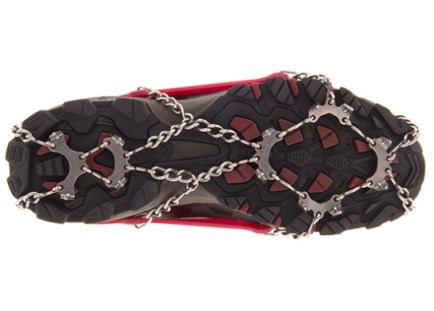Micro crampons or mini spikes have become a popular alternative to walking crampons with many winter hill walkers, but do they offer enough security for the changeable ground conditions found in our winter mountains? Discover what the experts think in our article below, and make up your own mind.
What are Micro crampons or mini spikes?
The term covers a range of different products which provide extra grip in snow and icy conditions. This is usually achieved using a combination of underfoot chains and short metal spikes. Some models offer little more than a chain, others are almost (but not quite) a full walking crampon - the most popular lie somewhere in between.

Chains and spikes of a popular mini spike © Kahtoola.com
Why are they popular?
Short spikes make walking on flat icy or snowy paths much easier and more comfortable than when wearing a walking crampon. Combined with a fast and simple attachment system and the ability to be used on softer, lighter footwear than a walking crampon this makes them an interesting option for those intending to travel on non-technical terrain, particularly well-pitched mountain footpaths. The ability to be fitted to fell running and approach shoes also opens up options for climbers and runners.
What are their limitations?
Walking crampons meet a PPE standard which includes a minimum strength of the points, frame and attachments. Mini spikes do not, so although many are well made it can be a bit of a lottery whether they will stand up to the knocks and scrapes of a full day out in the hills.
Shorter, less aggressive spikes provide less grip than a walking crampon does on hard refrozen snow or ice, especially when the surface is sloping rather than flat. Much of the support provided by a walking crampon comes from the fact that it has to be mounted on a fairly stiff and supportive boot, with the crampon frame working to provide lateral support - you don't get this support and control with mini spikes on a soft shoe or boot, making a slip or slide more likely.
What do the experts think?
We spoke to Elfyn Jones (BMC Cymru) to get his view on mini spikes - Elfyn is an active member of Llanberis MRT which covers Snowdon, a very popular objective for winter hill walkers.
"The Rescue team will actually carry mini spikes with us in winter, to give to people whom we are called out to rescue but who are without crampons to help them get down off the hill. There isn't much point giving them crampons as their boots often aren't suitable and mini spikes are better than nothing.
Mini spikes are often fine for most of a days walk in soft snow but problems occur when conditions change, as they often do. An easy ascent up sun-softened snow can become much more arduous and challenging in descent if the temperature has dropped and the snow refreezes and surfaces ice up.
It's also about considering the consequences of a slip or fall. If a slip would result in nothing more than a bruised bum and ego, mini spikes are probably an appropriate choice of kit. If, however, as is the case on most of the footpaths on Snowdon, the result of a simple trip or slide can be a long slide or fall over a drop onto steep ground and rocky slopes. On this terrain there is little chance to arrest a slide using an ice axe self-arrest, so your safety relies on not slipping in the first place. A good boot and walking crampon will be far better at ensuring this under all possible conditions, so this is what we recommend people choose."
Make up your own mind
Of course, much of the joy of hill walking comes from the freedom and lack of rules - you can do whatever you want! Experienced winter walkers may well be able to make sound judgements based on a route and the conditions and choose to use mini spikes, but when compared to walking crampons, mini spikes often won’t provide the necessary security when winter walking in the high mountains. Whatever equipment you choose, carefuly consider your route and the conditions, and always be ready to turn back before you get out of your depth.
Join online today by Direct Debit and save 25% on your first year's membership.
WATCH: What does the BMC do for hill walkers?
GET THE KNOWLEDGE: BMC resources for hill walkers
« Back
This article has been read
12050
times
TAGS
Click on the tags to explore more